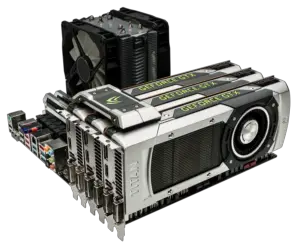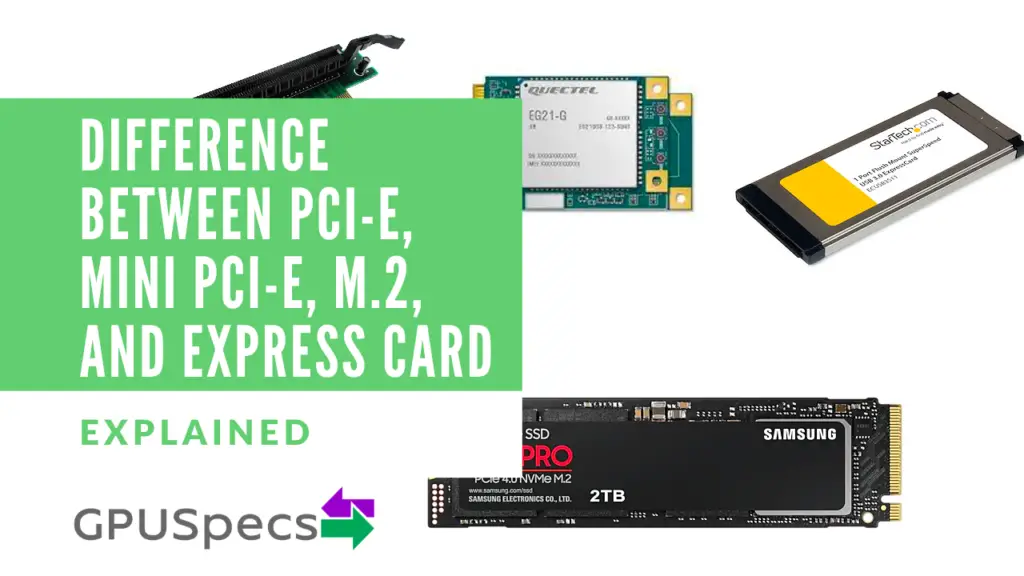Difference Between CrossFire and SLI - AMD CrossFire Vs Nvidia SLI
If you’ve ever wanted or even though about using multiple graphics cards within one system, then the chances are you’ve come across the terms AMD CrossFire and Nvidia SLI. In short, these are two technologies which allow the use of 2-4 graphics cards to be used simultaneously for better (gaming) performance.
Although these technologies seem very similar, since one is for AMD and the other Nvidia, they have some fundamental differences which you may want to consider.
We will also discuss the usability of SLI and CrossFire because although it may be a good way to get some better performance there are quite a few downsides to these technologies too.
Table of Contents
More Articles to View
Difference Between CrossFire and SLI - AMD CrossFire Vs Nvidia SLI Simple Table
| Technology | Compatible Graphics Cards | Motherboards | Errors | Extra stuff |
|---|---|---|---|---|
| AMD CrossFire | A lot of graphics cards can be mixed and matched as long as they are architecturely the same | Any motherboard with enough PCI-e slots | Common | Works with APUs, Doesn't need a bridge |
| Nvidia SLI | Only the exact same graphics card can be linked | Only SLI certified boards | Not as Common | Needs SLI Bridge, Doesn’t work with integrated GPUs |
AMD CrossFire

AMD CrossFire, sometimes referred to as CrossFireX, is AMD’s name for calling the technology which supports the linking of multiple graphics cards in order to improve theoretical performance.
The technology was first released in 2005 and required compatible motherboards and graphics cards.
AMD Hybrid graphics is the name of the technology in which mobile graphics are used with dedicated graphics cards.
Earlier versions of CrossFire required a CrossFire cable but this has since been removed on the newer graphics cards. The technology allows for different graphics cards to be connected together with different memory amounts as long as they’re from the same family. If your CPU is an APU then Crossfire is available by linking the GPU in your APU to your graphics card.
| Positives | Negatives |
|---|---|
| Works with other graphics cards from the same family with different memory configurations | Doesn't increase VRAM by linking more cards |
| APU can be CrossFire with your dedicated GPU | Some versions require CrossFire Bridge |
| Works on a lot more graphics cards (than Nvidia) | Doesnt Improve Your Performance by as much as you would expect |
| Works on lots of motherboards | Graphical glitches and errors are common |
| Newer versions don't use CrossFire Bridge | More Heat and Power Consumed but is not proportional to the performance increase |
Nvidia SLI

Nvidia SLI, also know as Scalable Link Interface is Nvidia’s name for calling their technology which allows multiple graphics cards to be connected together for better theoretical performance. SLI uses parallel processing algorithms to create a single output on a display.
An SLI bridge is required for transmitting information between each graphics card. It works in a master-slave configuration in which each graphics card take on equal load but is sent back to the master for display output. Unlike AMD’s CrossFire, SLI requires all the graphics cards to be the exact same with the same memory amount.
| Positives | Negatives |
|---|---|
| Provides more performance but not by 2x | More Heat and Power consumed but is not proportional to the performance increase |
| More sturdy and less prone to errors and crashes than AMD Crossfire | Not all Games Well oppptimized for multiple GPUs |
| Allows you to get more performance out of the top end hardware at high resolutions and quality settings | Has to be identical GPUs and uses a Bridge |
Similarities Between CrossFire and SLI

Both AMD CrossFire and SLI are fundamentally the same. They allow multiple graphics cards to be connected to each other for improved performance.
Both don’t scale performance linearly. For example adding another graphics card of the exact same type whether it be Nvidia or AMD will not increase the performance by 100%.
Neither increase the memory by adding another graphics card. The memory will be that of the master graphics card.
Both use the same two methods of processing frames:
- Split Frame Rendering (SFR or Scissor Frame Rendering in AMD’s terms) is when each frame is split into how many pieces it needs. Each GPU will then work on their separate pieces independently. Once the processing has been completed, the parts are combined together to get the full frame.
- Alternate Frame Rendering (AFR) is when each GPU works on alternating frames. For example the first GPU may work on frame 1 whereas the second GPU will be working on frame 2 and the third on frame 3 and so on. This then repeats and so is called alternate frame rendering.
Both AMD CrossFire and Nvidia SLI support multiple monitors by using the ports on the master graphics card. Both also don’t let you use the ports on any other graphics card except for the master’s.
Difference Between AMD CrossFire and Nvidia SLI

There are fundamental differences between Nvidia SLI and AMD Crossfire. We will go through some of these.
AMD CrossFire can work with APUs. This means you can CrossFire your dedicated graphics card with your integrated gpu. Nvidia does not support this.
AMD’s crossfire allows different graphics cards with different memory amounts to be connected as long as it is from the same architecture family. This means graphics cards from different vendors, with different clockspeeds, memory amounts and different GPUs can be CrossFired together. This is in contrast to Nvidia SLI where it has to be the exact same graphics card with the same memory.
This means you can connect an RX 560 and RX 580 together and won’t need to worry about the speeds, memory, etc. If you want to use Nvidia then you need two of the same card like two RTX 2080s. This may seem like AMD CrossFire has the advantage but there are more errors and problems which arise from AMD CrossFire due to the loose restrictions.
AMD CrossFire works on a lot more motherboards and graphics cards – including lower end graphics cards such as the RX 560. The reason for this is that SLI requires motherboard manufacturers to pay a licensing fee and also require minimum PCI-E requirements for their boards to be SLI certified.
All AMD CrossFire Requires is the PCI-e slots to connect each graphics card to and no licensing. This gives AMD the loose restrictions edge but can cause compatibility issues.
AMD CrossFire graphics cards no longer require the bridge or connector that they used to. They communicate via the PCI express slot and therefore do not require a bridge. This means that only Nvidia uses bridges for communication within their respective technology.
The PCI-E slots are capable of providing high bandwidth and therefore provide no performance decrease by not using a bridge. Over the years, Nvidia has developed their SLI bridge. Currently they have their NVLINK Bridge used mainly on Quadro graphics cards which provide up to 200GB/s of bandwidth when using 2.
Due to limitations within AMD CrossFire, all games are in full screen only unless the developers have programmed to game with CrossFire support. Nvidia SLI doesn’t suffer from this problem as games can be turned to windowed mode.
Is it worth using multiple GPUs?

The answer here depends massively on what you plan on doing. As always we suggest you get a higher end single graphics card than 2 lower end graphics cards.
SLI and CrossFire both still have their limitations and don’t usually provide the performance increase you would expect.
However, if you have planning on using high end graphics cards (2080 Tis or even Quadros) then you can increase the performance quite significantly.
As shown above you can expect to get some really decent performance increases in some games. It’s important to note the resolution as the performance increase usually appears a lot better at higher resolutions.
So if you plan on using high resolutions and multiple monitors with high end graphics cards then there is definitely some really good performance increases to be had.
If you have one graphics card and plan to upgrade, we would recommend just getting a new graphics card unless the graphics card you have is fairly high end.
Conclusion
We have seen the differences between AMD CrossFire and Nvidia SLI. Both these technologies are currently decreasing in use and Nvidia have only included SLI on their higher end cards (RTX 2080 and higher).
For this reason we can’t really recommend using SLI or CrossFire unless you plan to use very high resolutions with high quality.
For everyday gaming the highest single graphics card will more than likely be enough for all games you can currently get.
Overall AMD Crossfire is more loosely restricted but has more problems than Nvidia. Nvidia heavily restricts the graphics card types and motherboards that work with SLI but it is more robust and less prone to errors. Check more articles here.




